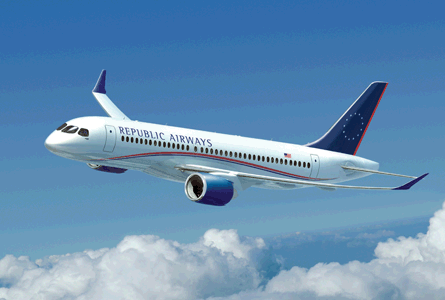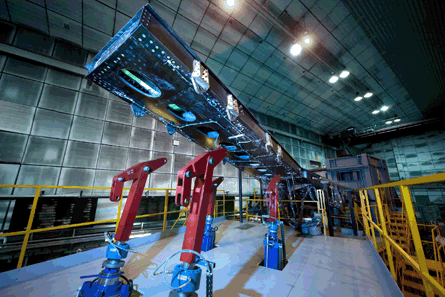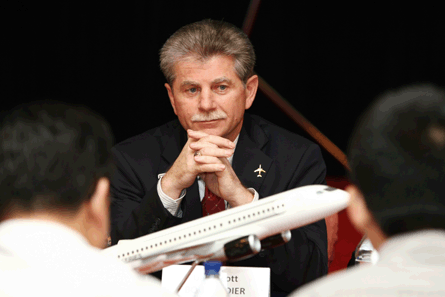If the contest for Republic Airways Holdings' narrowbody order had not been a contest, and merely involved a creatively financed, unchallenged arrangement between the US carrier and Bombardier, then it is safe to say that the aviation industry would not exactly be buzzing about the CSeries, and Airbus and Boeing would not be evaluating the resilience of their current narrowbody hives.
But the competition for Republic's business was real. Bombardier pitted its 110- to 130-seat Pratt & Whitney PurePower PW1500G geared turbofan-powered CSeries against members of the most successful narrowbody programmes in history, and emerged triumphant, with a firm order for 40 CSeries CS300s plus 40 options, which when coupled with previously secured firm orders and options from Lufthansa and Irish lessor LCI equates to a total of 180 CSeries commitments.
 |
|---|
© BombardierBombardier saw off the likes of Airbus and Boeing to win the Republic CSeries deal |
Deliveries of 138-seat, single-class CS300s to Republic's new Frontier Airlines subsidiary will begin in the second quarter of 2015, about a year-and-a-half after the first CSeries, a CS100, is due to enter service in late 2013. For Airbus and Boeing, the Republic contest "was the scary point in that it was the first time when they had real competition. They put their products against the CSeries. It was a good competition and they lost," says Avitas senior vice-president of consultancy Adam Pilarski.
"To me, this was serious. I think it was a wake-up call and everything to do with [Airbus and Boeing's current] re-engining studies comes from that," adds Pilarski, who felt compelled to express a similar opinion to Airbus's chief salesman John Leahy in March at the International Society of Transport Aircraft Trading (ISTAT) conference in Orlando. "At ISTAT, I got annoyed with John Leahy, who called Bombardier 'snowmobile producers', and I said, 'look, John, there was a real competition and you lost'."
It is little wonder, then, that Bombardier is heading to the Farnborough air show with a new spring its step, or as Forecast International senior aerospace analyst Raymond Jaworowski describes it, with "wind in their sales".
However, all eyes are now on the Canadian airframer to maintain that excitement, and produce more orders in the near term. "I think Farnborough will be important for them. That's not to say that if no orders are announced, it will collapse the programme, but if they don't, they'll have to announce something by the end of the summer to keep up that momentum we're talking about," says Jaworowski.
Even Teal Group's vice-president analysis Richard Aboulafia, who has traditionally taken a more sceptical view of the CSeries, particularly the 110-seat CS100, concedes that "a few more Republic-type orders, where there is a competition and where you can't write it off as 'Lufthansa being too clever by half with its fleet planning'", would cement Bombardier's status as a "major league" jetliner producer.
THE WORKER BEE
Bombardier is ready to assume the moniker "worker bee". "We have a great aircraft and it is really optimised for the market of 100-150 seats. That's point one, and I think today that is acknowledged by all our customers - many of those are common to Boeing and Airbus - and it is being acknowledged by Boeing and Airbus to the extent that they are looking at putting the geared turbofan on their products. So I do believe that the industry agrees that this is truly a game changer," says Bombardier Commercial Aircraft president Gary Scott, who formerly worked as vice-president and general manager for the Boeing 737/757 programmes.
Reaching CSeries design freeze this month, the manufacturer is fully confident its mainline jetliner will perform as advertised. It has already taken the CSeries aluminium-lithium fuselage demonstrator to 60,000 cycles, the equivalent of one lifetime, and has met few discoveries. Made by Shenyang Aircraft in China - which will produce the production fuselage - the demonstrator will be tested to a total 180,000 cycles at Bombardier's Saint-Laurent plant outside Montreal.
Meanwhile, at Bombardier's Belfast plant, the airframer has been putting stress on the CSeries carbonfibre-wing demonstrator, bending it to the limit. Scott says that Bombardier has opted not to go past ultimate load testing and break the wing, as originally intended. "Now we're thinking we'll probably stop at ultimate load and continue to test the wing because the testing has gone so well and it gives us opportunities to continue for weight improvements and reductions."
Detailed design phase for the CSeries will be completed early in 2011, after which Bombardier will move into the build phase for parts. The manufacturer plans to fly the CSeries in 2012 and deliver the first aircraft the following year. By the time first delivery takes place, however, the airframer will have already been testing the CSeries in the virtual world for about three years.
Nick Heymann, head of global industrial infrastructure at privately held brokerage Sterne, Agee, says Bombardier is on the verge of helping the market realise that, in offering a new-design aircraft with the P&W geared turbofan engine, "they really have kind of smashed the sound barrier in terms of incremental performance".
Baseline target for the engine alone is a 16% fuel reduction, "which when we met recently with P&W, has [the] potential to be 40-45% higher - ie, a 20-25% improvement [plus] 50% reduction in NOx, 15% in CO2, 12% reduction in maintenance and an overall 20% reduction in total lifecycle costs", said Heymann during a recent interview with consultancy IAG.
 |
|---|
© BombardierThe carbonfibre wing demonstrator is tested to its limit in Belfast |
He notes that 40% of airline costs today come from jet fuel "so you can save 6-7% over the best state-of-the-art equipment on the market today, and potentially this might grow to 8-10%".
But Bombardier's Scott downplays the suggestion that the CSeries will pose a full-blown threat to Airbus and Boeing's most significant narrowbody weapons, the A320 and 737NG, respectively. "As we've always said, our aircraft is intended to address the market that is largely ignored by Boeing and Airbus today. They serve it with downsized versions of their 737s and Airbus products, just as Embraer tries to serve it with upsized versions of their regional jets, but they've enjoyed a pretty exclusive duopoly heretofore because nobody has produced an optimised solution. Now we have and they acknowledge it."
PREPARING FOR BATTLE
More than just acknowledging the CSeries, Airbus and Boeing are readying to mount an assault on the twinjet. The CSeries "is sufficiently in the ballpark" that they have to take it seriously, says Avitas's Pilarski, adding that the immediate solution for Airbus and Boeing to counter the threat is "at least to get the engine, which provides a big part of the advantage they [Bombardier] have".
Airbus tested P&W's geared turbofan demonstrator engine in late 2008 through early 2009 on its A340 flight-test aircraft, and is now formally evaluating the powerplant together with CFM International's Leap X high-bypass turbofan under a proposed new engine option (NEO) for the A320.
The Leap X has been selected to power China's Comac C919, a direct future competitor to Airbus and Boeing in the 150- to 200-seat narrowbody market expected to enter service in 2016. But Airbus executive vice-president programmes Tom Williams recently singled out the CSeries family as the greatest danger to its single-aisle family, saying Airbus "must not be complacent and sit back" assuming Bombardier is "just going to attack" smaller A320 variants. "Once they've establish a beachhead, I'd imagine they'd want to roll up the rest of the products."
Boeing, meanwhile, expects to make a final decision this year on re-engining the 737 or opting for a clean-sheet replacement of its narrowbody family. The company has acknowledged that its planned production increase for the 737 family is driven, in part, by new programmes such as the CSeries.
WELL POSITIONED
Looking well-positioned to capture re-engining business for its geared turbofan is P&W. In addition to providing the 24,000lb-thrust (107kN) class PW15000G variant for the CSeries, P&W has been selected to supply the 17,000lb-thrust PurePower PW1200G for Japan's 70- to 96-seat Mitsubishi MRJ regional jet and to develop a 30,000lb-thrust engine for Russia's all-new 150- to 210-seat Irkut MS-21 twinjet.
But some industry observers wonder if P&W can really sit comfortably in CSeries meetings when the firm is also talking to Airbus about the A320 NEO and Airbus is being very vocal about its intention to destroy the CSeries business case.
When asked if this dynamic poses a quandary to P&W, the engine-maker provides a measured response. "The attractiveness of [the CSeries] is that, when we look at the 100- to 145-passenger market over the next 20 years, it's a little bit over 6,500 aircraft, so that's a pretty significant market. Certainly Airbus and Boeing today basically have a duopoly on that whole market, so that was our attractiveness to the CSeries and as the airplane and our engine develops, and it gets closer and closer to life, we're pleased that we're seeing the market interest that we have," says Bob Saia, P&W vice-president, next-generation product family.
"Our focus at the engine level was first to leverage our initial two models, the MRJ and the CSeries, to position ourselves for the 30,000lb-thrust market, which as you know represents the lion's share of the single-aisle market."
 |
|---|
© Bombardier"We have a great aircraft and it is really optimised for the market of 100-150 seats"Gary ScottPresident, Bombardier Commercial Aircraft |
Saia notes that the MS-21 business "gets us into the 30,000lb-thrust class", which will cover "something like an [Airbus] A319 up to a 220-passenger aircraft, so our focus has really been in making sure we have the right technology, the right architecture and the right optimised design and let the airframe manufacturers do the final selection".
WEIGHING THE OPTIONS
Should Airbus and or Boeing opt to re-engine their current-generation narrowbodies, they must consider the impact on aircraft values, says Pilarski. "All the owners of the [current] aircraft then start freaking out because they see the value of their aircraft plummet."
Cost of re-engining is also a major consideration. "When you take a partially used aircraft, perhaps with 50,000 or more cycle times on its airframe, you really are looking at an aircraft that might cost $12-15 million in the used market today. You put $10 million or $12 million into engines on it, and modifications, you're looking at a $20-25 million aircraft investment," says Sterne, Agee's Heymann.
At the same time, however, if Airbus and Boeing sit on their hands and do nothing, they take a big risk in allowing the CSeries to gain traction. Bombardier already has a "running start" with the CSeries, says Teal Group's Aboulafia. "Ironically, the one thing that could make it a huge success is if Airbus and Boeing stayed quietly horizontal, and stick with the mantra that 'people love our current product, our backlog is huge, and we'll be building this for decades to come'," he says.
Left unchallenged, Bombardier could also decide to roll out a larger-sized CSeries, as Airbus's Williams suggests. "I think Airbus and Boeing are certainly concerned about that. If the CSeries does turn out to be successful, will Bombardier use that as a stepping stone to get further into their territory?" asks Forecast International's Jaworowski.
EMBRAER WILD CARD
Bombardier has held fast to its stated plan to develop a 100- to 125-seat CS100 and 120- to 149-seat CS300, dismissing reports to the contrary as speculation. But Aboulafia and other analysts believes the Canadian airframer must move into the 150-plus seat category, particularly if its arch-rival Embraer moves to re-engine its E-Jets family, of which the largest member - the 195 - is capable of seating 122 passengers at maximum density.
"If Embraer re-engines then that product looks really a bit like a CS100 killer," says Aboulafia. "The centre of the market is increasingly gravitating towards the A320 and 737-800. So what's the point of [Bombardier] going after the diminishing part of the market when, for a relatively modest investment, you can go after a much greater segment, 150 seats," he says, adding that the CS300 - and not the CS100 - should be Bombardier's primary CSeries model. A 150-seater would "complement" this primary model, he says.
Embraer this year expects to decide whether to re-engine its E-Jets and incorporate newer technology in the airliners, or bring a larger-capacity, clean-sheet design to market. "It's difficult to see how they could do that [build a new-design aircraft] and do anything else in the aerospace world. Whereas, for the relatively simple and expedience of re-engining, they could cement their lock on the 70- to 110-seat segment and possibly be able to stretch - although they have gone back and forth on that [the stretch option]."
HOME MARKET
Meanwhile, the re-engining studies being undertaken by Airbus, Boeing and Embraer are not the only signs that the CSeries now poses a serious threat. Airbus and Boeing have also been pressing Bombardier to adhere to a financing pact between the manufacturers that prohibits them from using their home market export credit agencies to guarantee financing of aircraft orders for customers in each other's home markets.
Bombardier does not support the so-called "Country Home Rule". "It's an unwritten agreement between Boeing and Airbus that's not based on any international law or sanctioned by any organisation," says Bombardier's Scott. "We have said that this is an unfair agreement, sort of an exclusive club and doesn't maintain a level playing field for the rest of us."
The Organisation for Economic Cooperation and Development (OECD) has now agreed to take up the home rule issue in parallel with its current work on creating a new aircraft sector understanding (ASU) agreement, which will address another concern from Airbus and Boeing involving the classification of the CSeries as a Category 2 regional jet. A Category 2 distinction would permit the Canadian government to take advantage of more beneficial export credit financing than can be obtained for larger Category 1 jets.
The OECD "expects to have resolution on the financing side by the end of the year", says Scott, "but they have not said when they'll have resolution on the home market rule. This cannot be an agreement [simply] between Boeing and Airbus. If there is such an agreement, it has to be based on international law."
VIRTUAL HELP MAKES CSERIES REALITY
Long before a prototype Bombardier CSeries exists in composite and aluminium-lithium, the aircraft will exist in the virtual world thanks to the creation of a Complete Integrated Aircraft Systems Test Aircraft (CIASTA), which is on track to become operational before the end of 2010.
Montreal-based simulator manufacturer CAE is supplying the host analysis computer for CIASTA, as part of a far broader package of near-term deliverables to Bombardier from its so-called Augmented Engineering Environment suite, which includes an engineering simulator [E-SIM] that will have the ability to interface to real aircraft hardware/software systems; a computing environment to interface with Bombardier's integrated system test certification rig and a CAE 700 Series full-flight simulator to assist with flight-test certification testing.
 |
|---|
© CAECAE is supplying the host analysis computer for CIASTA |
But CAE is also providing crucial engineering support to the simulation integration activities, and, as such, will play an important role helping to make the CSeries a reality. "The CSeries is just exiting joint definition phase [JDP] and exit criteria includes providing specifications for simulation models from each supplier [with] delivery in 2010. This is the year when we integrate all the [system] simulation models and virtually fly the aircraft in the simulation environment well ahead of the prototype aircraft," says CAE vice-president of core engineering Marc St Hilaire.
CAE has acted as an OEM aircraft development partner in the past, notably working with Embraer on the 170 regional jet engineering development station, which included the development of fly-by-wire control laws; and with Airbus on a flight-test support and research full-flight simulator with roll-on/roll-off A340/A380 Airbus cockpits for flight-test rehearsal, among other projects. But Hiller says CIASTA is "unique".
"That vision of using simulation very early in the programme for a complete aircraft to validate the design early on before the [aircraft exists] is a new concept, and definitely worthwhile," he says.
Pratt & Whitney, whose PurePower PW1500G geared turbofan engines will power the 110- to 130-seat CSeries, is equally enthused about the benefits of CIASTA.
"We will introduce a full-authority digital engine control system into the CIASTA and that will operate just like it would on the engine and allow the integration of the FADEC to the aircraft systems that are simulated or actually installed in the CIASTA. What it allows us to do early is to optimise the software integration to make the aircraft as efficient as possible," says P&W vice-president next generation product family Bob Saia.
 |
|---|
© BombardierBombardier's Mirabell plant - CIASTA smallest on right |
The facility that will house CIASTA at Bombardier's Mirabel plant has been erected. "We will actually receive our first part, our first test part, for the CIASTA in October of this year. It is happening fast, and on schedule," says Bombardier Commercial Aircraft president Gary Scott.
Hiller has 10 CAE employees working non-stop on the CSeries programme, and envisages a team upwards of 30 on the entire work package at the peak of the CIASTA project. Two CAE employees "will live at Bombardier permanently" to support Bombardier with connecting the models, and integrating the aircraft in the simulation environment, he says.
The CAE executive notes that CIASTA represents a seven-year effort for CAE. "Part of our contractual engagement to Bombardier includes support for the complete aircraft certification programme two years after entry into service. It means that even after the aircraft has entered service and changes have been made to the aircraft, the E-SIM and the CIASTA package will be used to support those changes, and used to validate those changes before they are made to the aircraft."
Source: Flight International
















